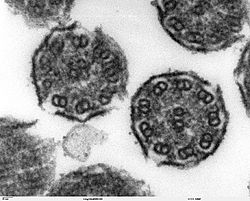Cytoskeleton
The cytoskeleton is a kind of scaffolding present in all cells. It is made of protein.
It keeps cell shape, protects the cell and enables cells to move (using structures such as flagella and cilia). It helps transport inside the cytoplasm (the movement of vesicles and organelles, for example), and in cell division. The concept and the term (cytosquelette, in French) was introduced by French embryologist Paul Wintrebert in 1931.[1]
Eukaryote cells contain three main kinds of cytoskeletal filaments, which are microfilaments (actin filaments), intermediate filaments, and microtubules. They give the cell structure and shape.[2] Cytoskeletal elements interact closely and often with the cell membrane and the endoplasmic reticulum.[3]
Cytoskeleton Media
Movement of organelles in Tradescantia stamen hair cells
References
- ↑ Frixione E (2000). "Recurring views on the structure and function of the cytoskeleton: a 300-year epic". Cell Motility and the Cytoskeleton. 46 (2): 73–94. doi:10.1002/1097-0169(200006)46:2<73::AID-CM1>3.0.CO;2-0. PMID 10891854.
- ↑ Minton AP (October 1992). "Confinement as a determinant of macromolecular structure and reactivity". Biophys. J. 63 (4): 1090–100. doi:10.1016/S0006-3495(92)81663-6. PMC 1262248. PMID 1420928. Archived from the original on 2008-09-07. Retrieved 2010-01-14.
- ↑ Doherty GJ and McMahon HT (2008). "Mediation, modulation and consequences of membrane-cytoskeleton interactions". Annual Review of Biophysics. 37: 65–95. doi:10.1146/annurev.biophys.37.032807.125912. PMID 18573073. Archived from the original on 2020-06-05. Retrieved 2010-01-14.
| Wikimedia Commons has media related to Lua error in Module:Commons_link at line 62: attempt to index field 'wikibase' (a nil value).. |


